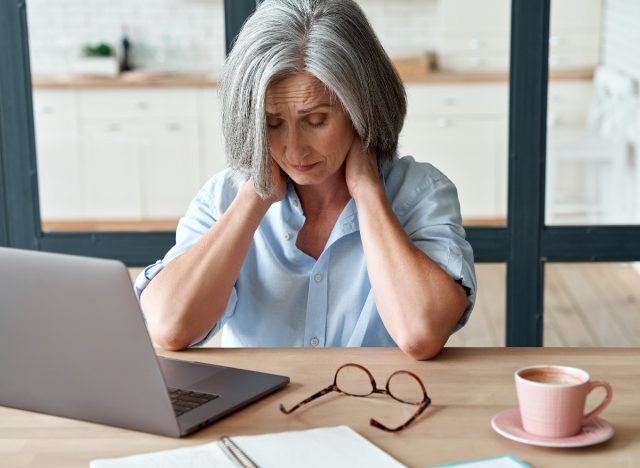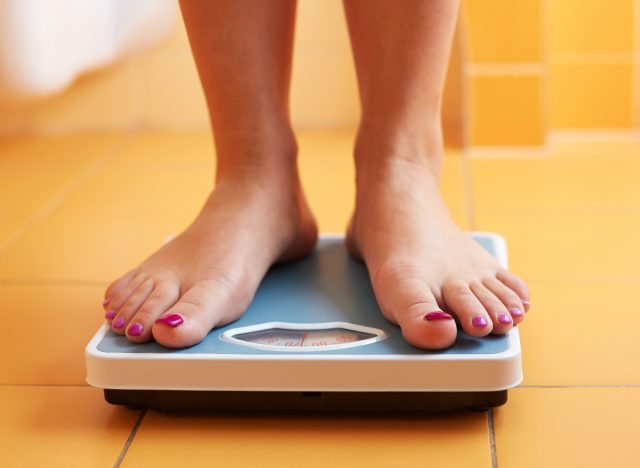Whether you work from home or at a desk job, you know all too well what it’s like sitting for extended periods of time. Sitting for eight hours a day without stretching your body has become somewhat the norm—and you should be incredibly cautious of it. It may seem pretty harmless at the time; however, extended sitting and inactivity can have a massive impact on your overall health.
We spoke with experts who share exactly what happens to your body when you sit for eight hours a day, so listen up. You’re at your desk working, which means you’re likely not thinking about the negative impact sitting has on your mental and physical wellness.
“Having a largely sedentary lifestyle can have a disastrous impact on your overall health, on your metabolism, and on your joints,” explains Emily Schofield, gym manager and personal trainer at Ultimate Performance Los Angeles. “Prolonged periods of inactivity can lead to all sorts of physical health issues, in particular, poor posture, loss of muscle strength, and weight gain.”
Let’s delve further into just how bad sitting for eight hours a day can be.
In This Article:
1. You may experience neck pain.

When you’re sitting, you’re probably more focused on your work than your posture. This can cause “increased thoracolumbar kyphosis,” or rounding of the spine. In turn, this may lead to neck pain starting at the base of your skull and extending to the top of your shoulders, creating headaches.
“Most ‘postural abnormalities’ are flexible, meaning they are changeable with conscious effort,” says Landon Crowder, PT, DPT, OCS, clinic director and physical therapist at Baton Rouge Physical Therapy. “However, this may increase the likelihood of this habitual position becoming stiffer or rigid in the long term. Standing and moving more throughout the day decreases this risk.”
2. You may lose muscle mass.

Your muscular system can be greatly compromised with a sedentary lifestyle, aka sitting at a desk all day.
“Normal age-related muscle atrophy (sarcopenia) leads to males and females losing 3% to 5% of muscle mass per decade after 30. This increases post-menopause in females and males, especially after 60,” explains Crowder.
The best ways to avoid muscle loss are consuming a nutritious diet and working physical activity into each day. Muscles require a lot of energy to maintain them. Crowder points out, “If [you] never challenge [your muscles], your body decides it doesn’t need to devote the resources required to maintain muscle mass because [your] body considers muscle mass non-essential. This leads to the ‘normal’ decrease in muscle mass we see. The less active we are, the more rapid this decline is.”
3. You may begin to find daily tasks more challenging.

As you grow into your 40s and 50s, when your metabolism slows, it’s really important to be active daily.
“It is the old adage of ‘use it or lose it,'” stresses Schofield. “If we become couch potatoes and don’t move our bodies and our joints, the simple tasks such as climbing the stairs, carrying our groceries, and getting in and out of the bath that we take for granted in our 20s and 30s become a lot harder in our 60s and 70s.”
4. You may put on weight.

This may go without saying, but if you’re sedentary a good part of the day, you’re not burning as many calories as you would if you were up and around. A double no-no is if you’re snacking while you’re sitting!
Crowder tells us, “Moving from standing for eight hours to sitting for eight hours would nearly account for a one-pound gain in fat/week if all other variables were equal. If you are trying to lose weight, it is almost impossible (not to mention not healthy) to eat few enough calories to offset a very sedentary lifestyle. Increasing activity and muscle mass significantly improves weight loss efforts as muscle is very metabolically active and burns far more calories throughout the day, even at rest.”
Alexa Mellardo










